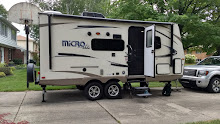Saturday and Sunday,
April 6 & 7: It was nice this morning to afford ourselves a leisurely rising and
time around the pool chatting with Pat and drinking (her) coffee. We ate the
bananas and breads we had bought the night before and
then completed our packing to go to the airport and bid Panama good-bye. We
were annoyed to find that we had $1.10 left on our toll road card and, though
the toll was $1.15, they wouldn't allow us to pay the 5 cents extra; we had to
put $5.00 more on the card and use it to pay the nickel. GOTCHA!! :-( After
turning in the car, checking our bags and going through immigration we still
had plenty of time to sit around. Before boarding we had to go through yet
another full security check and then we were on our way. It was another
uneventful flight (the best kind!) and they fed us a lunch and we watched
"Parental Development" and some TV shows which made the time pass
quickly. In Houston we encountered our first major frustrations of the trip. It
took a very long time to go through Immigration and then we went outside and
called for the Hyatt Courtesy Van. Kris had gotten the reservation because, if
we had flown straight through, it would have been $300 more per ticket. Instead
we had rooms for about $75.00 per couple. Kris was told it would take 30
minutes to arrive so we went inside and drank a cup of coffee away from the
many smokers outside. We went back outside and, after 45 minutes, called to see
where the van was. Kris was told that the driver had come and waited 15 minutes
(that was impossible) and left without us. They also said he wouldn't be back
for an hour. We were all beside ourselves with frustration and rage, not helped
because it was 7:00, we hadn't had dinner and we were really tired by then.
Kris ranted a bit at the woman and checked to see about going someplace else.
But it was going to be much more expensive and the Hyatt was non-refundable
because he got it as an online deal. Luckily the van returned a little less
than an hour later and took us to the Hyatt, where we checked in. At that point
we found out that their Courtesy Van doesn't run 24 hours a day so we wouldn't
be able to take it back the next morning. A taxi ride was going to add to the
cost of our cheap rooms. But since Kris had apologized for ranting at her and
because the deal indicated we would have the van, she gave us two slips for
free appetizers. After putting our things in the really beautiful rooms (this
was probably the nicest motel we've ever stayed in) we went down to the lobby
bar and grill and had dinner while we watched U/M beat Syracuse to go to the
Final game of the NCAA tournament. I was too exhausted to last the whole time
so I went up, took a shower, and saw the very end of it before going to sleep
about 11:00. The 3:30 wake-up call was really hard to take, but we were told to
be at the airport 2 hours before our 6:00AM flight. We weren't however told
that United doesn't open their check-in until 4:30 and the only one there
to explain anything to the small crowd that was gathering was a real grouch who
would only repeat "We don't open until 4:30" as she turned her back
on the asker and walked away. Once we were in we had breakfast and everything
went as it was supposed to. We flew to Chicago and then on to Lansing where
Kris and Heidi's son, Aaron met us with his son, Levi, and car keys to replace
the ones Kris couldn't find. Both cars started right up and we bid our friends
good-bye after one of the best and most adventurous Spring Breaks yet.
At San Blas Islands:
At Embera Quera
OUR PANAMA BIRDS LIST
At Cabana Potosi:
Blue-gray tanager
Crimson-backed tanager
White winged tanager
Two injured Blue-headed Parrots
Red-lored Amazon Parrot--Cone has been with the family since he
was a baby. 28 years old and will live to be 70s
Warbler
Red-legged Honeycreeper (found dead & kept in freezer for
burial)
Salt Tater (brown with face patches) sparrow-like
Orange billed sparrow
Green violet-ear hummingbird
Two Keel-billed toucans
Pair of Gray-necked Wood-Rail
Blue-crowned Motmot
Clay-colored robin
At San Blas Islands:
Long tailed grackel
White ibis
Black ibis
Snowy Egret
Black hawk
Swallows
Bare-throated Tiger-heron
Little Blue Heron
Plover
Caracara
Dove
Lineated Woodpecker (looked like our pileated)
Great Kingfisher
At Embera Quera
Great Kiskadee
Slate tailed Trogon
Anhinga
Great Kingfisher
Hummingbird
Golden hooded Tanager
Common Moorhen
Osprey
Masked Tytira
Jacinta
Yellow Warbler
Black Vulture
Snowy Egret






























































